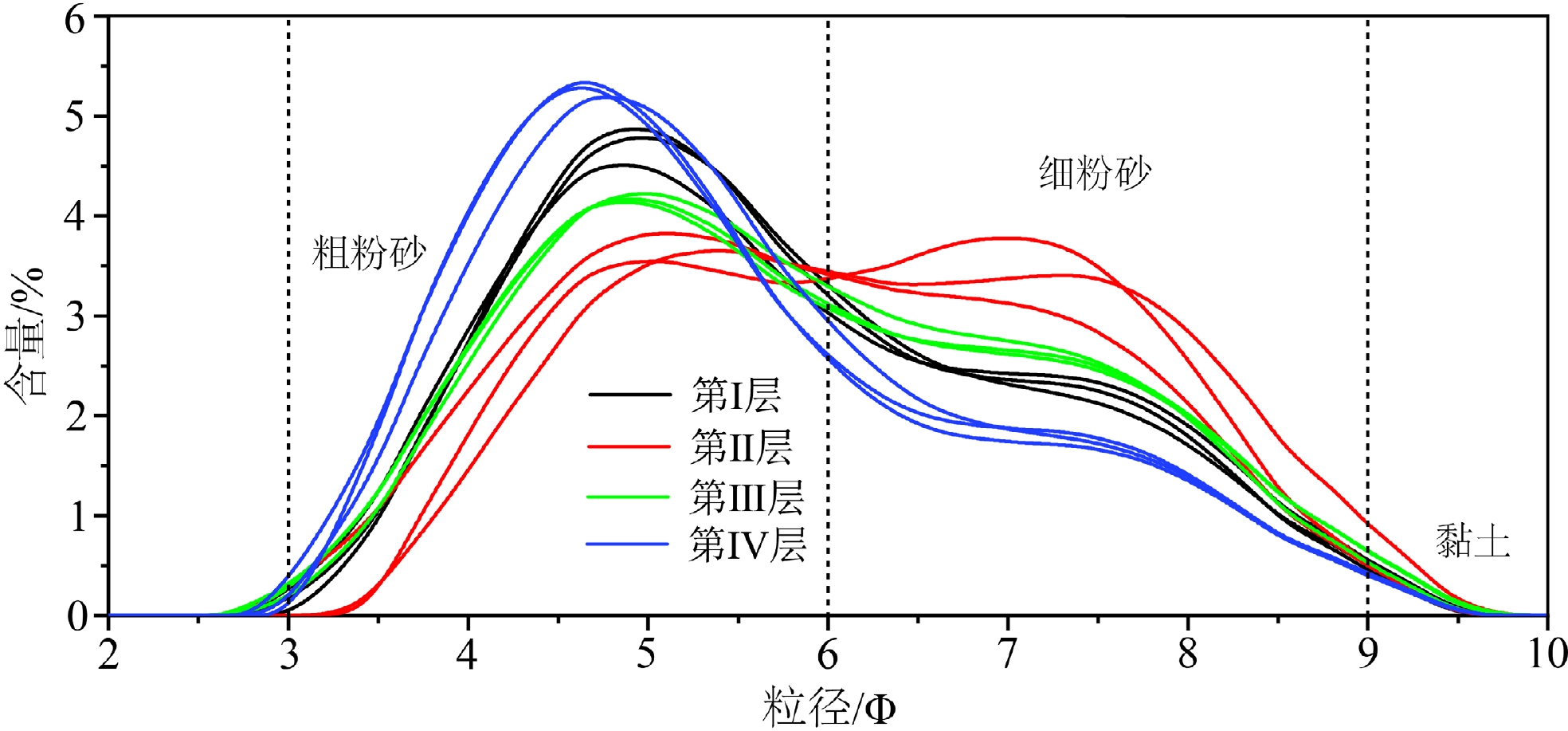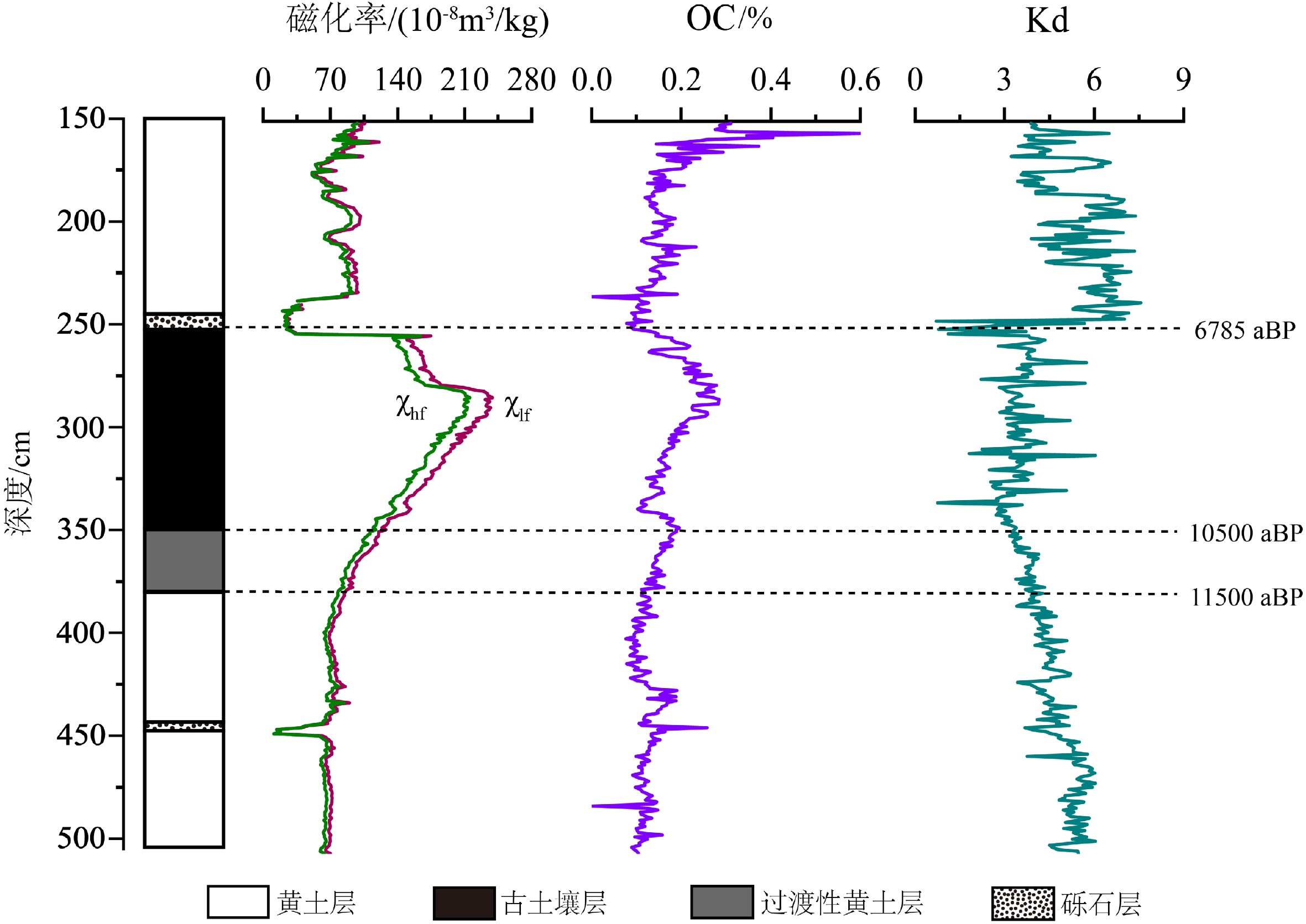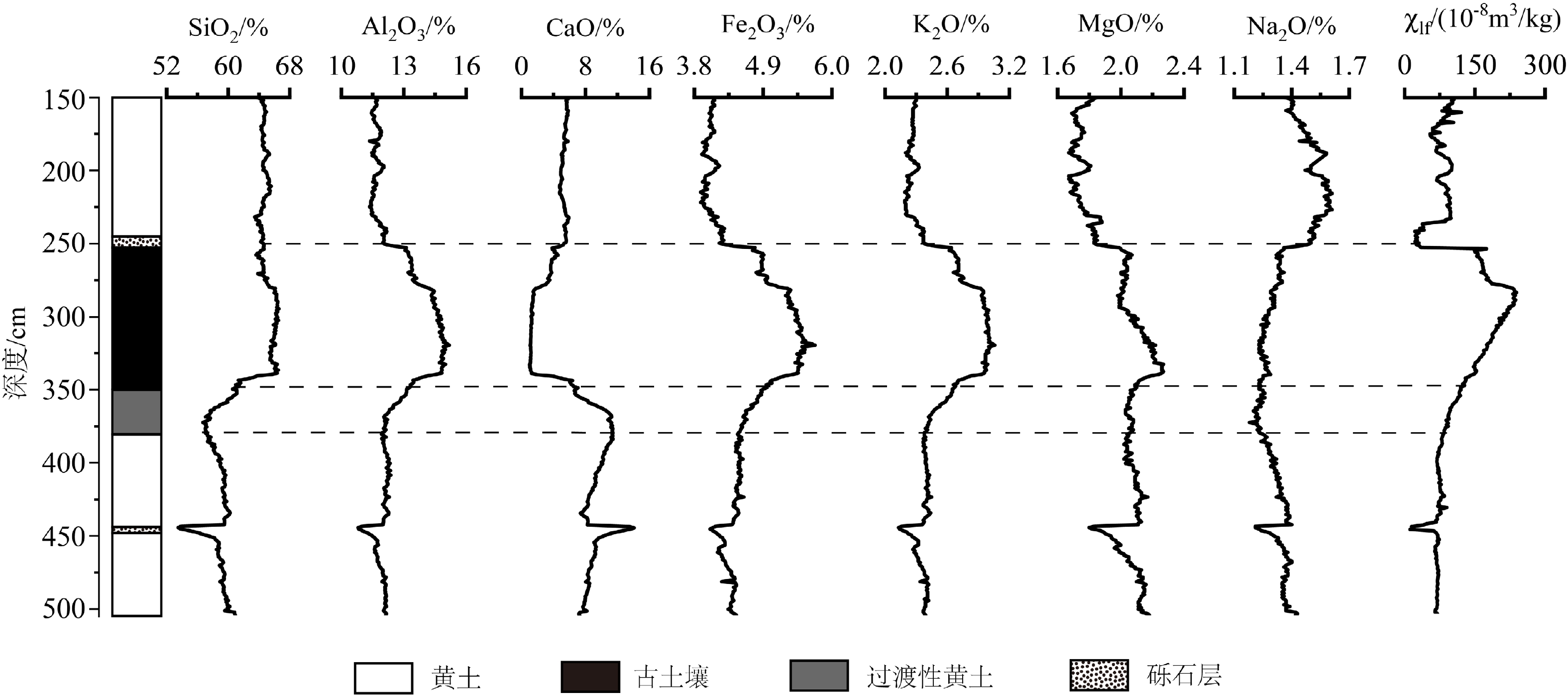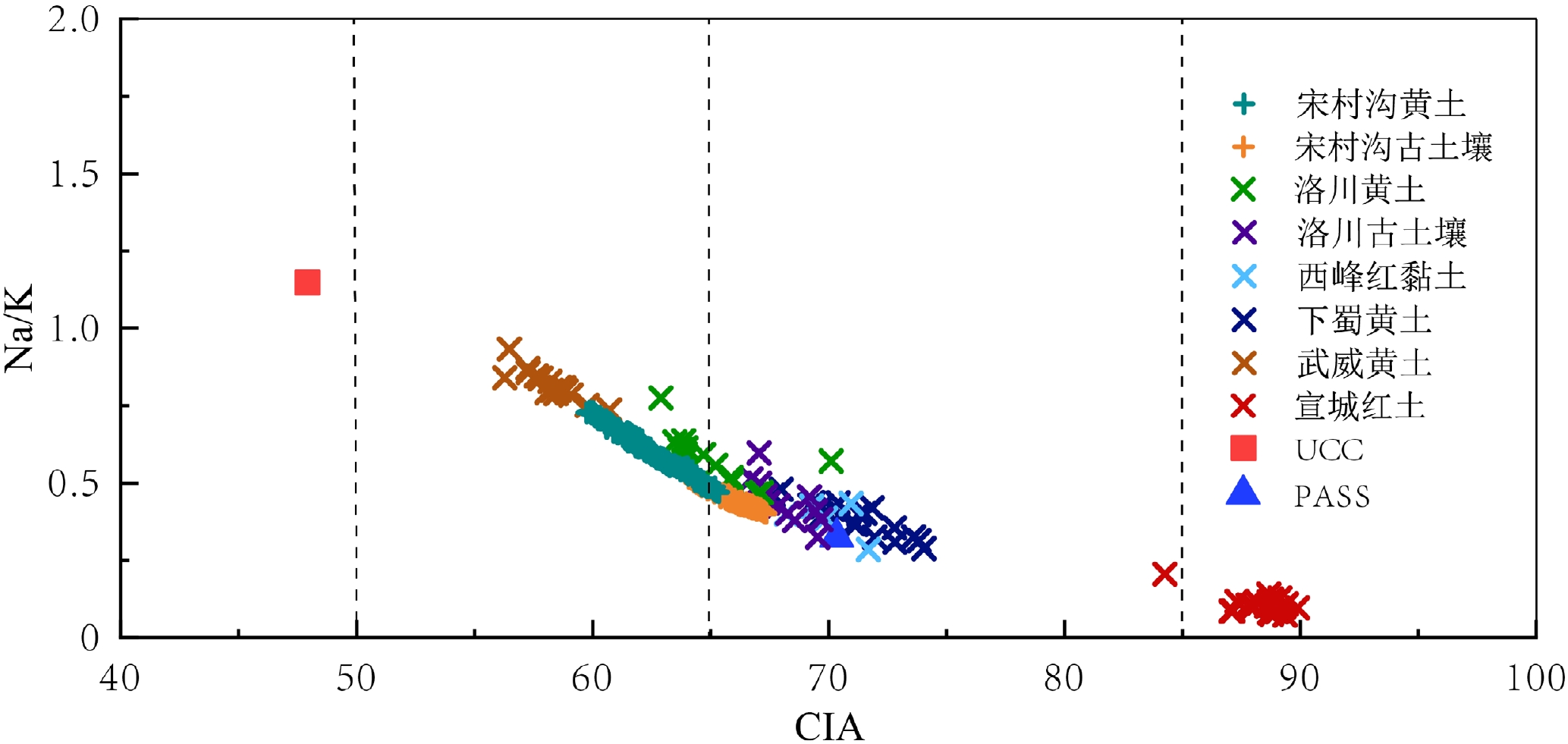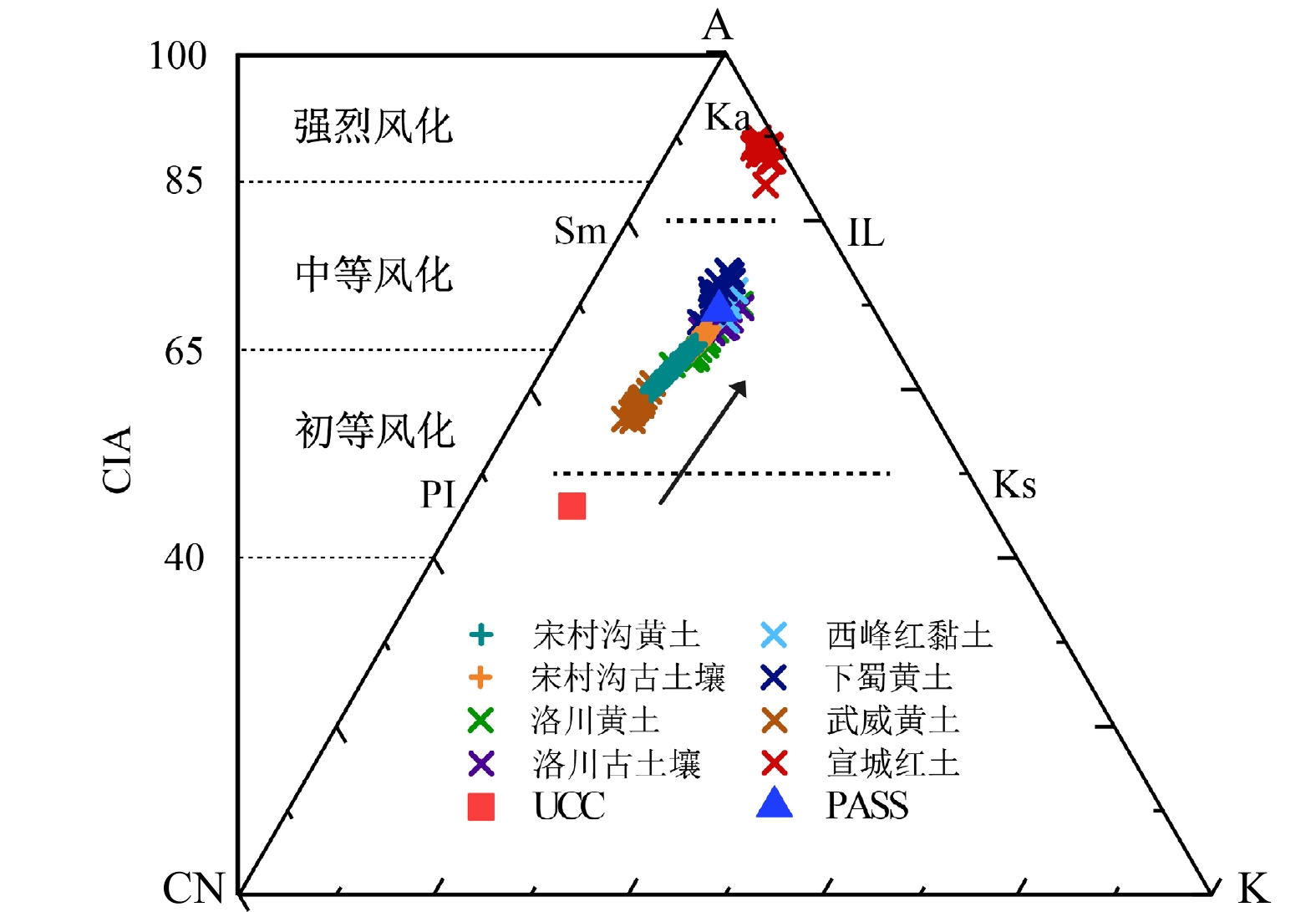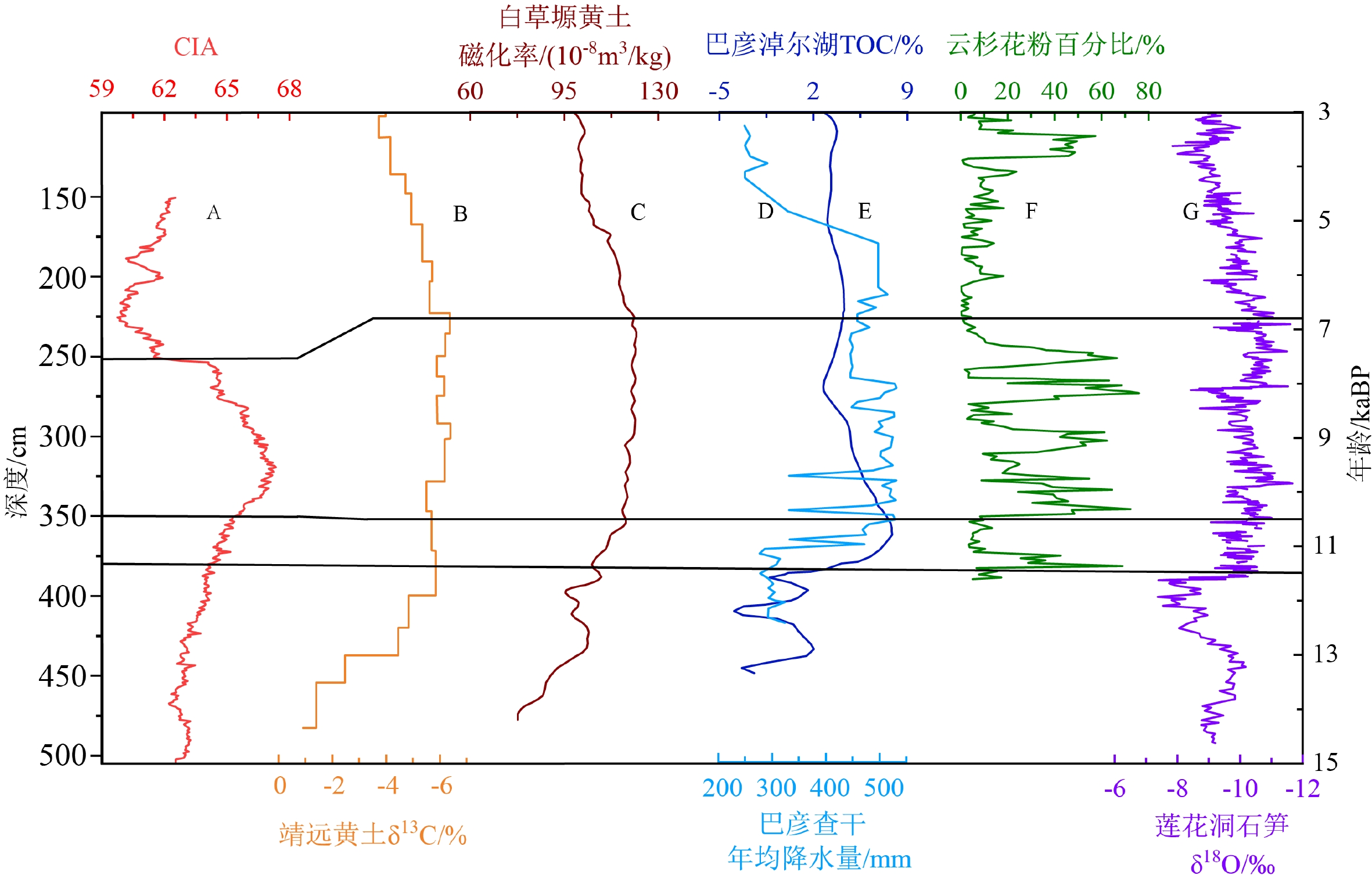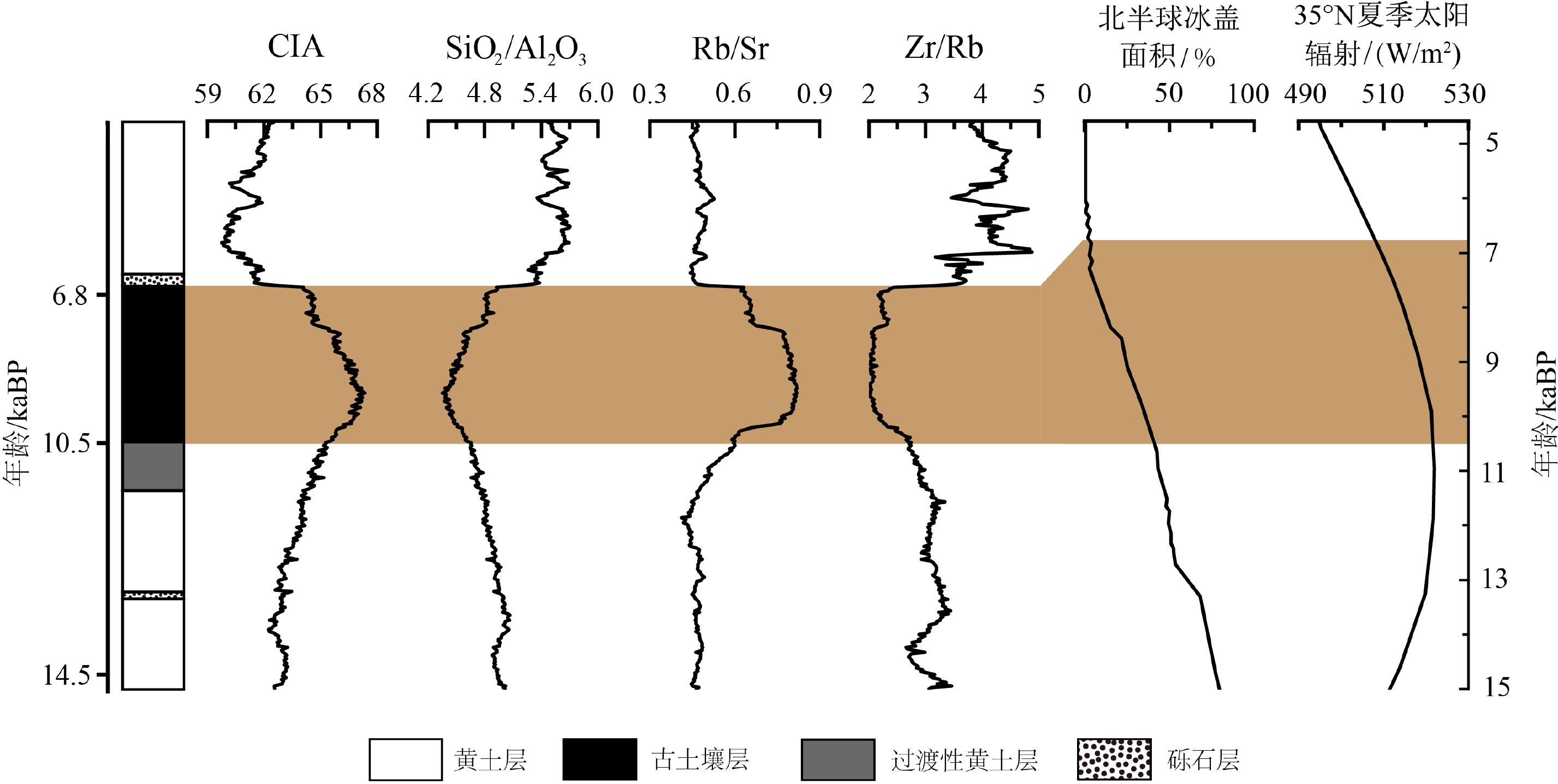Characteristics of weathering of the loess-paleosol sequences in the Late Glacial Period to Middle Holocene in Linfen Basin and implication for climatic significance
-
摘要:
了解中国北方晚冰期和全新世时期的气候环境变化及其驱动机制,有助于预测未来气候变化的可能情景。基于黄土高原东南缘临汾盆地的黄土-古土壤剖面,在3个AMS14C年代的支持下,通过粒度、磁化率、土壤有机碳以及地球化学元素等指标,重建了临汾盆地晚冰期至中全新世晚期的气候变化历史。结果表明:宋村沟剖面的黄土和古土壤分别处于初等和中等化学风化阶段,而不同地区风成堆积物的化学风化强度存在明显差异,主要受控于东亚夏季风的区域变化。多指标综合分析表明,晚冰期以来临汾盆地的气候演变经历了4个阶段:晚冰期东亚冬季风较强,气候干冷;早全新世东亚夏季风强化,气候向暖湿转变;早中全新世东亚夏季风达到峰值,为最暖湿的适宜期;中全新世晚期东亚夏季风减弱,气候再次转向干冷;临汾盆地的气候变化主要受控于北半球太阳辐射强度和冰量的变化。
Abstract:Exploring the climate and environmental changes and the driving mechanisms during the Late Glacial and Holocene in the northern China is vital to predicting the possible scenarios of future climate change. Based on the loess-paleosol profile of Linfen Basin in the southeastern margin of the Loess Plateau, we analyzed three AMS14C dates, grain size, magnetic susceptibility, soil organic carbon, and geochemical elements, and reconstructed the climate change history of Linfen Basin from the Late Glacial Period to the middle and late Holocene. Results show that the loess and paleosol of the Songcungou section are in the early and middle chemical weathering stages, respectively. The chemical weathering intensity of aeolian deposits in different areas was obviously different, which is mainly controlled by regional variation of the East Asian Summer Monsoon (EASM) intensity. Comprehensive analysis of multiple indicators shows that climate evolution of the Linfen Basin has experienced four stages since the Late Glacial Period. (Ⅰ) In the Late Glacial Period, the East Asian Winter Monsoon (EAWM) was strong, and the climate was dry and cold. (Ⅱ) In the early Holocene, EASM was intensified and the climate became warm and humid. (Ⅲ) In the early Middle Holocene, EASM reached its peak, and the climate was warmest and wettest. (Ⅳ) In the late Middle Holocene, EASM weakened and the climate turned dry and cold again. The climate change in the Linfen Basin was mainly controlled by the changes of solar radiation intensity and ice volume in the Northern Hemisphere.
-
Key words:
- loess /
- Late Glacial Period /
- Holocene /
- East Asian monsoon /
- climate change
-

-
表 1 宋村沟剖面年代记录
Table 1. Age dating records of the Songcungou section
序号 实验室编号 深度/cm 材料 14C年龄/ aBP 校正年龄中值/cal.aBP 1 Beta-625760 260 有机沉积物 5960 ±30 6785 2 Beta-625761 350 有机沉积物 9350±30 10550 3 Beta-625762 490 有机沉积物 12500±40 14503 表 2 宋村沟剖面及其他风成沉积物常量化学元素平均含量
Table 2. Average content of major chemical elements of the Songcungou section and other aeolian deposits
土壤剖面 参数 SiO2/% Al2O3/% Fe2O3/% MgO/% CaO/% Na2O/% K2O/% TiO2/% CIA 宋村沟黄土(n=257) 平均值 61.16 11.93 4.30 1.94 7.71 1.39 2.34 0.41 62.66 变异系数 0.05 0.03 0.06 0.08 0.29 0.08 0.04 0.02 宋村沟古土壤(n=98) 平均值 65.20 14.23 5.25 2.10 2.41 1.28 2.88 0.48 65.91 变异系数 0.02 0.04 0.05 0.04 0.62 0.03 0.04 0.02 西峰红黏土[19](n=5) 平均值 63.75 15.05 5.28 2.89 0.90 1.16 3.00 0.76 70.01 武威黄土[20] (n=18) 平均值 58.77 11.37 2.70 2.86 7.91 1.77 2.16 0.70 58.21 下蜀黄土[21] (n=20) 平均值 68.07 13.32 5.30 1.61 1.00 0.92 2.35 0.81 71.04 洛川黄土[22] (n=13) 平均值 67.10 13.99 4.39 2.22 0.96 1.73 2.99 0.72 64.80 洛川古土壤[22] (n=12) 平均值 64.85 14.93 5.16 2.21 0.82 1.39 3.18 0.76 68.18 宣城红土[23] (n=21) 平均值 66.46 13.44 6.16 0.52 0.11 0.14 1.34 1.06 88.32 上陆壳[24] (UCC) 平均值 66.00 15.20 5.00 2.20 4.20 3.90 3.40 0.50 47.92 陆源页岩[24] (PASS) 平均值 62.80 18.90 7.22 2.20 1.30 1.20 3.70 0.16 70.36 -
[1] 刘东生. 黄土与环境[M]. 北京: 科学出版社, 1985
LIU Dongsheng. Loess and the Environment[M]. Beijing: Science Press, 1985.
[2] An Z S, Liu T S, Lu Y C, et al. The long-term paleomonsoon variation recorded by the loess-paleosol sequence in central China [J]. Quaternary International, 1990, 7-8: 91-95. doi: 10.1016/1040-6182(90)90042-3
[3] Jia Y F, Huang C C, Pang J L, et al. Chronology of the Holocene loess-paleosol section and its deposition and pedogenesis on the south of Chinese Loess Plateau [J]. Journal of Geographical Sciences, 2008, 18(4): 415-442. doi: 10.1007/s11442-008-0415-8
[4] Wang H P, Chen J H, Zhang X J, et al. Palaeosol development in the Chinese Loess Plateau as an indicator of the strength of the east Asian summer monsoon: evidence for a mid-Holocene maximum [J]. Quaternary International, 2014, 334-335: 155-164. doi: 10.1016/j.quaint.2014.03.013
[5] 王克鲁, 盛学斌, 严富华, 等. 山西临汾盆地黄土及其形成古环境[J]. 地震地质, 1996, 18(4):339-348
WANG Kelu, SHENG Xuebin, YAN Fuhua, et al. The loess and the paleo-environment for its formation in the Linfen Basin of Shanxi Province [J]. Seismology and Geology, 1996, 18(4): 339-348.
[6] 李拓宇. 山西陶寺遗址及临汾地区全新世环境演化与古文化发展[D]. 北京大学博士学位论文, 2013
LI Tuoyu. Holocene environmental change and cultural evolution of Taosi site and Linfen area of Shanxi Province[D]. Doctor Dissertation of Peking University, 2013.
[7] 田庆春, 杜五喜, 韩军青, 等. 末次间冰期以来临汾盆地气候演化特征: 以丁村古人类遗址东沟剖面为例[J]. 干旱区资源与环境, 2019, 33(12):139-144
TIAN Qingchun, DU Wuxi, HAN Junqing, et al. Climate evolution of Linfen Basin since the last interglacial period: case study of Donggou section near the ancient human site of Dingcun [J]. Journal of Arid Land Resources and Environment, 2019, 33(12): 139-144.
[8] 胡小猛, 王杜涛, 陈美君, 等. 山西临汾盆地末次冰期时段湖相沉积中的H, D/O事件记录[J]. 第四纪研究, 2014, 34(2):354-363 doi: 10.3969/j.issn.1001-7410.2014.02.09
HU Xiaomeng, WANG Dutao, CHEN Meijun, et al. The study on the records of H and D/O paleoclimatic events during the Last Glacial period from the lacustrine sediment in Linfen Basin, Shanxi graben [J]. Quaternary Sciences, 2014, 34(2): 354-363. doi: 10.3969/j.issn.1001-7410.2014.02.09
[9] Ramsey C B. Bayesian analysis of radiocarbon dates [J]. Radiocarbon, 2009, 51(1): 337-360. doi: 10.1017/S0033822200033865
[10] Reimer P J, Bard E, Bayliss A, et al. IntCal13 and Marine13 radiocarbon age calibration curves 0–50, 000 years cal BP [J]. Radiocarbon, 2013, 55(4): 1869-1887. doi: 10.2458/azu_js_rc.55.16947
[11] Blaauw M, Christen J A. Flexible paleoclimate age-depth models using an autoregressive gamma process [J]. Bayesian Analysis, 2011, 6(3): 457-474. doi: 10.1214/ba/1339616472
[12] Xu S J, Wang T. Comparative study on the grain size characteristics of loess deposit both on Miaodao Islands and on the Laizhou Bay plain and its implications for provenance [J]. Procedia Environmental Sciences, 2011, 10: 1869-1875. doi: 10.1016/j.proenv.2011.09.292
[13] Huang C C, Pang J, Su H, et al. Climatic and anthropogenic impacts on soil formation in the semiarid loess tablelands in the middle reaches of the Yellow River, China [J]. Journal of Arid Environments, 2007, 71(3): 280-298. doi: 10.1016/j.jaridenv.2007.03.010
[14] Heller F, Liu T S. Palaeoclimatic and sedimentary history from magnetic susceptibility of loess in China [J]. Geophysical Research Letters, 1986, 13(11): 1169-1172. doi: 10.1029/GL013i011p01169
[15] An Z S, Kukla G J, Porter S C, et al. Magnetic susceptibility evidence of monsoon variation on the Loess Plateau of central China during the last 130, 000 years [J]. Quaternary Research, 1991, 36(1): 29-36. doi: 10.1016/0033-5894(91)90015-W
[16] Bloemendal J, Liu X M, Sun Y B, et al. An assessment of magnetic and geochemical indicators of weathering and pedogenesis at two contrasting sites on the Chinese Loess Plateau [J]. Palaeogeography, Palaeoclimatology, Palaeoecology, 2008, 257(1-2): 152-168. doi: 10.1016/j.palaeo.2007.09.017
[17] 谢巧勤, 陈天虎, 徐晓春, 等. 西峰黄土-红粘土序列有机质记录及其对磁化率古气候意义启示[J]. 第四纪研究, 2012, 32(4):709-718 doi: 10.3969/j.issn.1001-7410.2012.04.16
XIE Qiaoqin, CHEN Tianhu, XU Xiaochun, et al. Organic matter record of Xifeng eolian deposits and its decipherment for the paleoclimatic proxy of magnetic susceptibility of the loess-red clay sequences in Chinese Loess Plateau [J]. Quaternary Sciences, 2012, 32(4): 709-718. doi: 10.3969/j.issn.1001-7410.2012.04.16
[18] 张虎才. 元素表生地球化学特征及理论基础[M]. 兰州: 兰州大学出版社, 1997
ZHANG Hucai. Supergene Geochemical Characteristics and Theoretical Basis of Elements[M]. Lanzhou: Lanzhou University Press, 1997.
[19] 陈旸, 陈骏, 刘连文. 甘肃西峰晚第三纪红粘土的化学组成及化学风化特征[J]. 地质力学学报, 2001, 7(2):167-175 doi: 10.3969/j.issn.1006-6616.2001.02.012
CHEN Yang, CHEN Jun, LIU Lianwen. Chemical composition and characterization of chemical weathering of Late Tertiary red clay in Xifeng, Gansu Province [J]. Journal of Geomechanics, 2001, 7(2): 167-175. doi: 10.3969/j.issn.1006-6616.2001.02.012
[20] 张虎才, 李吉均, 马玉贞, 等. 腾格里沙漠南缘武威黄土沉积元素地球化学特征[J]. 沉积学报, 1997, 15(4):154-160
ZHANG Hucai, LI Jiejun, MA Yuzhen, et al. A study on elemental geochemical characters of the Wuwei loess section in the south vicinity of Tengger Desert [J]. Acta Sedimentologica Sinica, 1997, 15(4): 154-160.
[21] 李徐生, 韩志勇, 杨守业, 等. 镇江下蜀土剖面的化学风化强度与元素迁移特征[J]. 地理学报, 2007, 62(11):1174-1184 doi: 10.3321/j.issn:0375-5444.2007.11.006
LI Xusheng, HAN Zhiyong, YANG Shouye, et al. Chemical weathering intensity and element migration features of the Xiashu loess profile in Zhenjiang [J]. Acta Geographica Sinica, 2007, 62(11): 1174-1184. doi: 10.3321/j.issn:0375-5444.2007.11.006
[22] 陈骏, 安芷生, 刘连文, 等. 最近2.5Ma以来黄土高原风尘化学组成的变化与亚洲内陆的化学风化[J]. 中国科学:D辑, 2001, 44(5):403-413 doi: 10.1007/BF02909779
CHEN Jun, AN Zhisheng, LIU Lianwen, et al. Variations in chemical compositions of the eolian dust in Chinese Loess Plateau over the past 2.5 Ma and chemical weathering in the Asian inland [J]. Science in China Series D:Earth Sciences, 2001, 44(5): 403-413. doi: 10.1007/BF02909779
[23] 李徐生, 杨达源, 鹿化煜. 皖南风尘堆积序列氧化物地球化学特征与古气候记录[J]. 海洋地质与第四纪地质, 1999, 19(4):75-82
LI Xusheng, YANG Dayuan, LU Huayu. Oxide-geochemistry features and paleoclimatic record of the aeolian-dust depositional sequence in southern Anhui [J]. Marine Geology & Quaternary Geology, 1999, 19(4): 75-82.
[24] Hao Q Z, Guo Z T, Qiao Y S, et al. Geochemical evidence for the provenance of middle Pleistocene loess deposits in Southern China [J]. Quaternary Science Reviews, 2010, 29(23-24): 3317-3326. doi: 10.1016/j.quascirev.2010.08.004
[25] Nesbitt H W, Young G M. Early Proterozoic climates and plate motions inferred from major element chemistry of lutites [J]. Nature, 1982, 299(5885): 715-717. doi: 10.1038/299715a0
[26] Nesbitt H W, Young G M. Prediction of some weathering trends of plutonic and volcanic rocks based on thermodynamic and kinetic considerations [J]. Geochimica et Cosmochimica Acta, 1984, 48(7): 1523-1534. doi: 10.1016/0016-7037(84)90408-3
[27] 冯连君, 储雪蕾, 张启锐, 等. 化学蚀变指数(CIA)及其在新元古代碎屑岩中的应用[J]. 地学前缘, 2003, 10(4):539-544 doi: 10.3321/j.issn:1005-2321.2003.04.019
FENG Lianjun, CHU Xuelei, ZHANG Qirui, et al. CIA (chemical index of alteration) and its applications in the Neoproterozoic clastic rocks [J]. Earth Science Frontiers, 2003, 10(4): 539-544. doi: 10.3321/j.issn:1005-2321.2003.04.019
[28] 刘秀铭, 刘植, 吕镔, 等. 塞尔维亚黄土的磁学性质及其环境意义[J]. 科学通报, 2013, 58(3):353-363 doi: 10.1007/s11434-012-5383-9
LIU Xiuming, LIU Zhi, LÜ Bin, et al. The magnetic properties of Serbian loess and its environmental significance [J]. Chinese Science Bulletin, 2013, 58(3): 353-363. doi: 10.1007/s11434-012-5383-9
[29] 苏志珠, 杨宗园, 李晋昌. 距今220 ka以来大同盆地沉积物磁化率反映的气候变化[J]. 冰川冻土, 2015, 37(2):401-407
SU Zhizhu, YANG Zongyuan, LI Jinchang. Climate change reflected by the magnetic susceptibility within the deposit sediment in Datong Basin, North China, since 220 kaBP [J]. Journal of Glaciology and Geocryology, 2015, 37(2): 401-407.
[30] Sun Y Q, Qi L, Heng F, et al. Analysis of generalized semiparametric mixed varying-coefficients models for longitudinal data [J]. Canadian Journal of Statistics, 2019, 47(3): 352-373. doi: 10.1002/cjs.11498
[31] Zhao G Y, Liu X M, Chen Q, et al. Paleoclimatic evolution of Holocene loess and discussion of the sensitivity of magnetic susceptibility and median diameter [J]. Quaternary International, 2013, 296: 160-167. doi: 10.1016/j.quaint.2012.06.015
[32] Ming G D, Zhou W J, Wang H, et al. Moisture variations in lacustrine−eolian sequence from the Hunshandake sandy land associated with the east Asian summer monsoon changes since the Late Pleistocene [J]. Quaternary Science Reviews, 2020, 233: 106210. doi: 10.1016/j.quascirev.2020.106210
[33] Jiang W Y, Guiot J, Chu G Q, et al. An improved methodology of the modern analogues technique for palaeoclimate reconstruction in arid and semi-arid regions [J]. Boreas, 2010, 39(1): 145-153. doi: 10.1111/j.1502-3885.2009.00115.x
[34] Dong J G, Shen C C, Kong X G, et al. Reconciliation of hydroclimate sequences from the Chinese Loess Plateau and low-latitude east Asian summer monsoon regions over the past 14, 500years [J]. Palaeogeography, Palaeoclimatology, Palaeoecology, 2015, 435: 127-135. doi: 10.1016/j.palaeo.2015.06.013
[35] An Z S, Porter S C, Kutzbach J E, et al. Asynchronous Holocene optimum of the east Asian monsoon [J]. Quaternary Science Reviews, 2000, 19(8): 743-762. doi: 10.1016/S0277-3791(99)00031-1
[36] 周卫健, 安芷生. 中国黄土高原14C年代学[M]//刘东升. 中国第四纪地质与环境. 北京: 科学出版社, 1991: 192-200
ZHOU Weijian, AN Zhisheng. 14C chronology of Loess Plateau in China[M]//LIU Dongsheng. Quaternary Geology and Environment in China. Beijing: Science Press, 1991: 192-200.
[37] Chen F H, Cheng B, Zhao Y, et al. Holocene environmental change inferred from a high-resolution pollen record, Lake Zhuyeze, arid China [J]. The Holocene, 2006, 16(5): 675-684. doi: 10.1191/0959683606hl951rp
[38] 陈骏, 季峻峰, 仇纲, 等. 陕西洛川黄土化学风化程度的地球化学研究[J]. 中国科学:D辑, 1998, 41(3):235-241 doi: 10.1007/BF02973110
CHEN Jun, JI Junfeng, QIU Gang, et al. Geochemical studies on the intensity of chemical weathering in Luochuan loess-paleosol sequence, China [J]. Science in China Series D:Earth Sciences, 1998, 41(3): 235-241. doi: 10.1007/BF02973110
[39] 汪海斌, 于英鹏, 刘现彬, 等. 黄土高原S1古土壤的地球化学特征及其对物源的指示[J]. 第四纪研究, 2011, 31(2):338-346 doi: 10.3969/j.issn.1001-7410.2011.02.16
WANG Haibin, YU Yingpeng, LIU Xianbin, et al. Geochemical characteristics of last interglacial paleosols in the Chinese Loess Plateau and its implications to loess provenance [J]. Quaternary Sciences, 2011, 31(2): 338-346. doi: 10.3969/j.issn.1001-7410.2011.02.16
[40] 刘连文, 陈骏, 陈旸, 等. 最近130ka以来黄土中Zr/Rb值变化及其对冬季风的指示意义[J]. 科学通报, 2002, 47(15):1298-1302 doi: 10.1360/02tb9288
LIU Lianwen, CHEN Jun, CHEN Yang, et al. Variation of Zr/Rb ratios on the Loess Plateau of central China during the last 130000 years and its implications for winter monsoon [J]. Chinese Science Bulletin, 2002, 47(15): 1298-1302. doi: 10.1360/02tb9288
[41] 彭淑贞, 郭正堂. 风尘堆积中SiO2/Al2O3值与粒度的关系及其对东亚冬季风的指示意义[J]. 中国科学:D辑, 2001, 44(S1):261-266 doi: 10.1007/BF02911995
PENG Shuzhen, GUO Zhengtang. Geochemical indicator of original eolian grain size and implications on winter monsoon evolution [J]. Science in China Series D:Earth Science, 2001, 44(S1): 261-266. doi: 10.1007/BF02911995
[42] Dyke A S. An outline of north American deglaciation with emphasis on central and northern Canada [J]. Developments in Quaternary Sciences, 2004, 2: 373-424.
[43] Peltier W R. Global glacial isostasy and the surface of the ice-age earth: the ICE-5G (VM2) model and grace [J]. Annual Review of Earth and Planetary Sciences, 2004, 32: 111-149. doi: 10.1146/annurev.earth.32.082503.144359
[44] Laskar J, Robutel P, Joutel F, et al. A long-term numerical solution for the insolation quantities of the earth [J]. Astronomy & Astrophysics, 2004, 428(1): 261-285.
[45] Li P, Zhang C X, Wu H B, et al. Geochemical characteristics of Holocene loess-paleosol sequences in central Chinese Loess Plateau and their implications for east Asian monsoon evolution [J]. Quaternary International, 2022, 616: 99-108. doi: 10.1016/j.quaint.2021.10.017
[46] Xiao J L, Si B, Zhai D Y, et al. Hydrology of Dali Lake in central-eastern Inner Mongolia and Holocene east Asian monsoon variability [J]. Journal of Paleolimnology, 2008, 40(1): 519-528. doi: 10.1007/s10933-007-9179-x
-



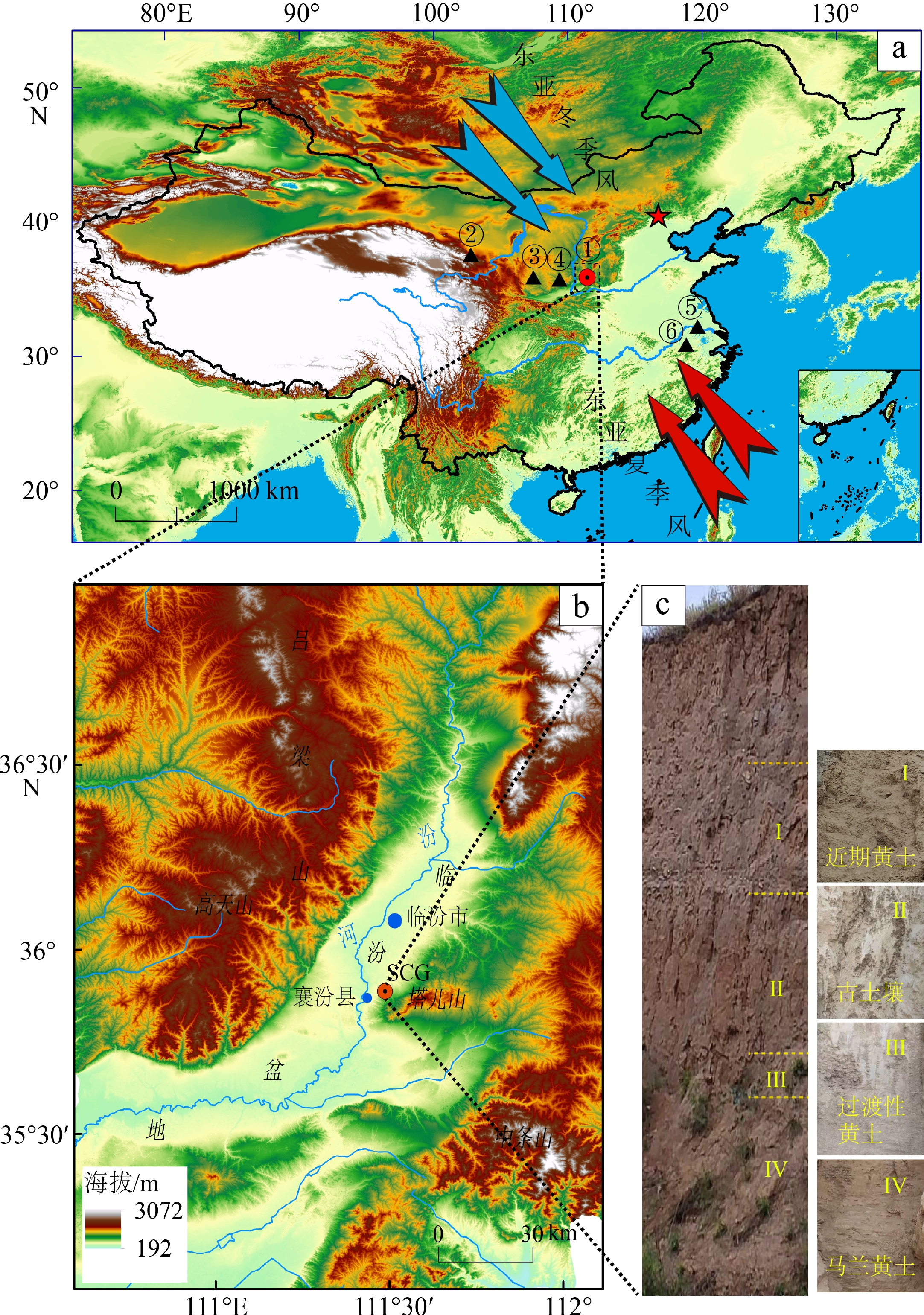
 下载:
下载:

